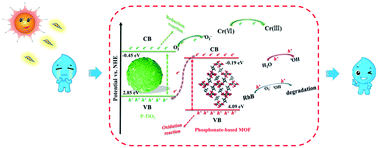当前位置:
X-MOL 学术
›
Environ. Sci.: Nano
›
论文详情
Our official English website, www.x-mol.net, welcomes your
feedback! (Note: you will need to create a separate account there.)
Construction of novel phosphonate-based MOF/P–TiO2 heterojunction photocatalysts: enhanced photocatalytic performance and mechanistic insight
Environmental Science: Nano ( IF 5.8 ) Pub Date : 2020/01/06 , DOI: 10.1039/c9en01180c Tianyu Zeng 1, 2, 3, 4 , Dajun Shi 4, 5, 6 , Qingrong Cheng 1, 2, 3, 4 , Guiying Liao 4, 7, 8, 9 , Hong Zhou 1, 2, 3, 4 , Zhiquan Pan 1, 2, 3, 4
Environmental Science: Nano ( IF 5.8 ) Pub Date : 2020/01/06 , DOI: 10.1039/c9en01180c Tianyu Zeng 1, 2, 3, 4 , Dajun Shi 4, 5, 6 , Qingrong Cheng 1, 2, 3, 4 , Guiying Liao 4, 7, 8, 9 , Hong Zhou 1, 2, 3, 4 , Zhiquan Pan 1, 2, 3, 4
Affiliation

|
Development of highly efficient photocatalysts for photocatalysis research has been a hot research area in recent years. Herein, the phosphate-based metal organic framework (MOF)/P–TiO2 hybrid composites (MOFx/P–TiO2) were first synthesized using the phosphonate-based MOF [Cd(H2L)]n (H4L = 2,5-dimethylbenzene-1,4-diylbis(methylene)diphosphonic acid) and phosphated mesoporous TiO2 beads (P–TiO2) using a versatile step-by-step self-assembly strategy for environmental remediation. The results showed that the Cd-MOF loading content in the MOFx/P–TiO2 has an important influence on the degradation of pollutants, and the hybrid materials could significantly enhance the photocatalytic activity for the photo-oxidative degradation of RhB (97.6% in 25 min over MOF1.5/P–TiO2) and the reduction of Cr(VI) (96.1% in 60 min over MOF0.5/P–TiO2) in comparison with the single-component Cd-MOF or P–TiO2. The enhancement of the photocatalytic activity of MOFx/P–TiO2 could be mainly attributed to: (i) the strong light absorption capacity, and (ii) the effective photogenerated charge separation and transfer through the coupled heterojunction interfaces of P–TiO2 and Cd-MOF. Furthermore, the results verified that the matched band structure of P–TiO2 and Cd-MOF could induce a superfast Z-scheme interfacial charge transfer path. Therefore, a reasonable Z-scheme charge transfer mechanism was proposed based on the active species trapping experiments and the results of electron spin resonance (ESR). More importantly, MOF0.5/P–TiO2 and MOF1.0/P–TiO2 possess a good stability and reusability after recycling five times owing to the high chemical stability of the Cd-MOF, P–TiO2 and heterojunctions. The present work provides a promising approach to construct direct Z-scheme porous heterojunctions for elimination of environmental pollutants.
中文翻译:

新型基于膦酸酯的MOF / P–TiO2异质结光催化剂的构建:增强的光催化性能和机理研究
近年来,用于光催化研究的高效光催化剂的开发一直是研究的热点。在此,首先使用基于膦酸酯的MOF [Cd(H 2 L)] n(H 4 L )合成了基于磷酸盐的金属有机骨架(MOF)/ P-TiO 2杂化复合物(MOF x / P-TiO 2)。= 2,5-二甲基苯-1,4-二基双(亚甲基)二膦酸)和磷酸盐化的介孔TiO 2珠(P–TiO 2),采用了一种多功能的逐步自组装策略进行环境修复。结果表明,MOF x / P–TiO 2中Cd-MOF的负载量对污染物的降解具有重要影响,杂化材料可以显着增强光催化活性,从而使RhB的光氧化降解(在25分钟内超过MOF 1.5 / P-TiO 2达到97.6%)和Cr(VI)(与单组分Cd-MOF或P-TiO 2相比,在60分钟内超过MOF 0.5 / P-TiO 2的96.1%)。MOF x / P-TiO 2的光催化活性增强主要归因于:(i)强大的光吸收能力,以及(ii)有效的光生电荷分离和通过P-TiO 2的耦合异质结界面转移和Cd-MOF。此外,结果证实了P–TiO 2和Cd-MOF的匹配能带结构可以诱导Z型界面电荷转移的超快路径。因此,基于活性物质的俘获实验和电子自旋共振(ESR)的结果,提出了合理的Z-方案电荷转移机制。更重要的是,由于Cd-MOF,P-TiO 2和异质结的高化学稳定性,MOF 0.5 / P-TiO 2和MOF 1.0 / P-TiO 2在循环五次后具有良好的稳定性和可重复使用性。目前的工作为构建直接Z提供了一种有前途的方法方案的多孔异质结,可消除环境污染物。
更新日期:2020-03-21
中文翻译:

新型基于膦酸酯的MOF / P–TiO2异质结光催化剂的构建:增强的光催化性能和机理研究
近年来,用于光催化研究的高效光催化剂的开发一直是研究的热点。在此,首先使用基于膦酸酯的MOF [Cd(H 2 L)] n(H 4 L )合成了基于磷酸盐的金属有机骨架(MOF)/ P-TiO 2杂化复合物(MOF x / P-TiO 2)。= 2,5-二甲基苯-1,4-二基双(亚甲基)二膦酸)和磷酸盐化的介孔TiO 2珠(P–TiO 2),采用了一种多功能的逐步自组装策略进行环境修复。结果表明,MOF x / P–TiO 2中Cd-MOF的负载量对污染物的降解具有重要影响,杂化材料可以显着增强光催化活性,从而使RhB的光氧化降解(在25分钟内超过MOF 1.5 / P-TiO 2达到97.6%)和Cr(VI)(与单组分Cd-MOF或P-TiO 2相比,在60分钟内超过MOF 0.5 / P-TiO 2的96.1%)。MOF x / P-TiO 2的光催化活性增强主要归因于:(i)强大的光吸收能力,以及(ii)有效的光生电荷分离和通过P-TiO 2的耦合异质结界面转移和Cd-MOF。此外,结果证实了P–TiO 2和Cd-MOF的匹配能带结构可以诱导Z型界面电荷转移的超快路径。因此,基于活性物质的俘获实验和电子自旋共振(ESR)的结果,提出了合理的Z-方案电荷转移机制。更重要的是,由于Cd-MOF,P-TiO 2和异质结的高化学稳定性,MOF 0.5 / P-TiO 2和MOF 1.0 / P-TiO 2在循环五次后具有良好的稳定性和可重复使用性。目前的工作为构建直接Z提供了一种有前途的方法方案的多孔异质结,可消除环境污染物。









































 京公网安备 11010802027423号
京公网安备 11010802027423号